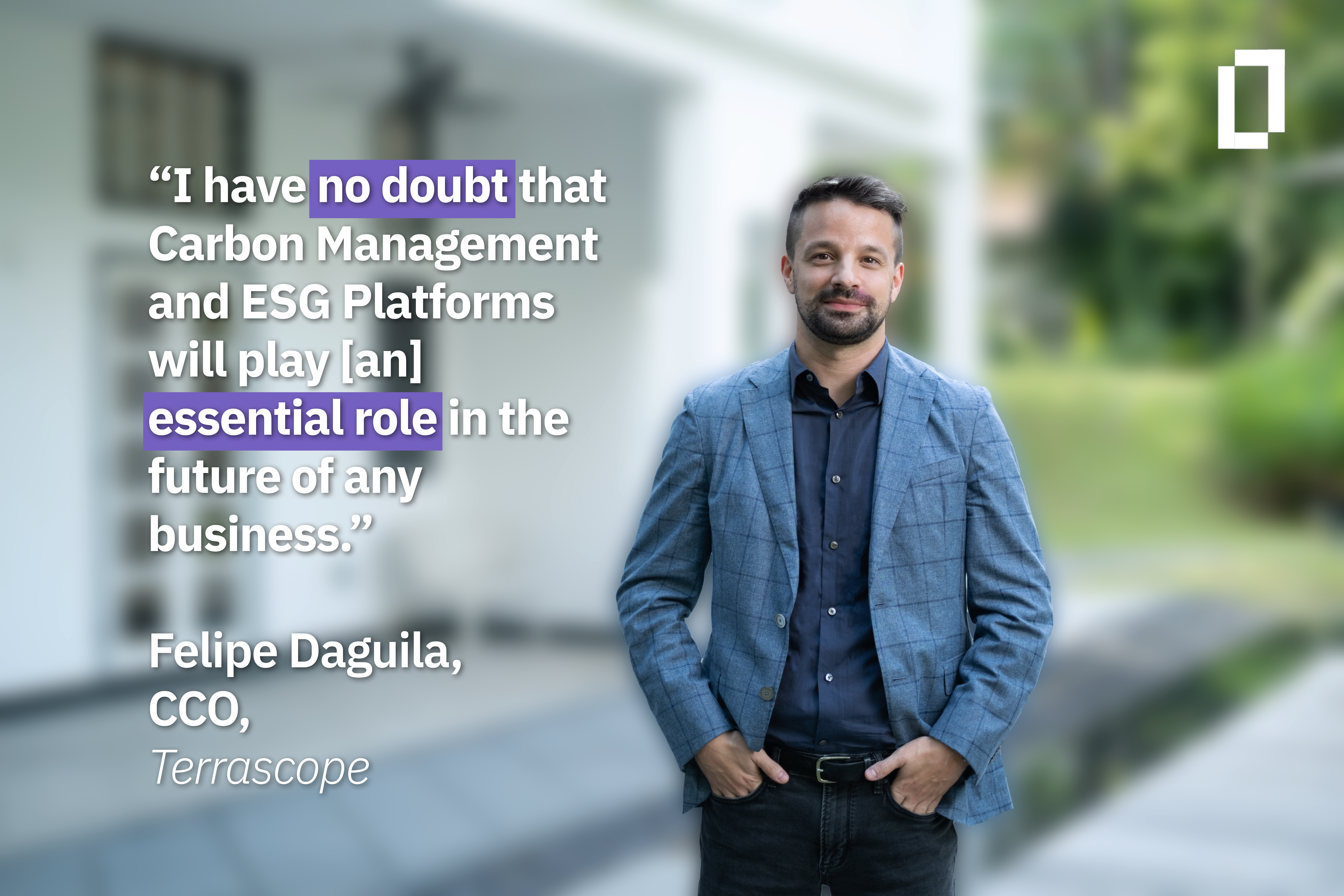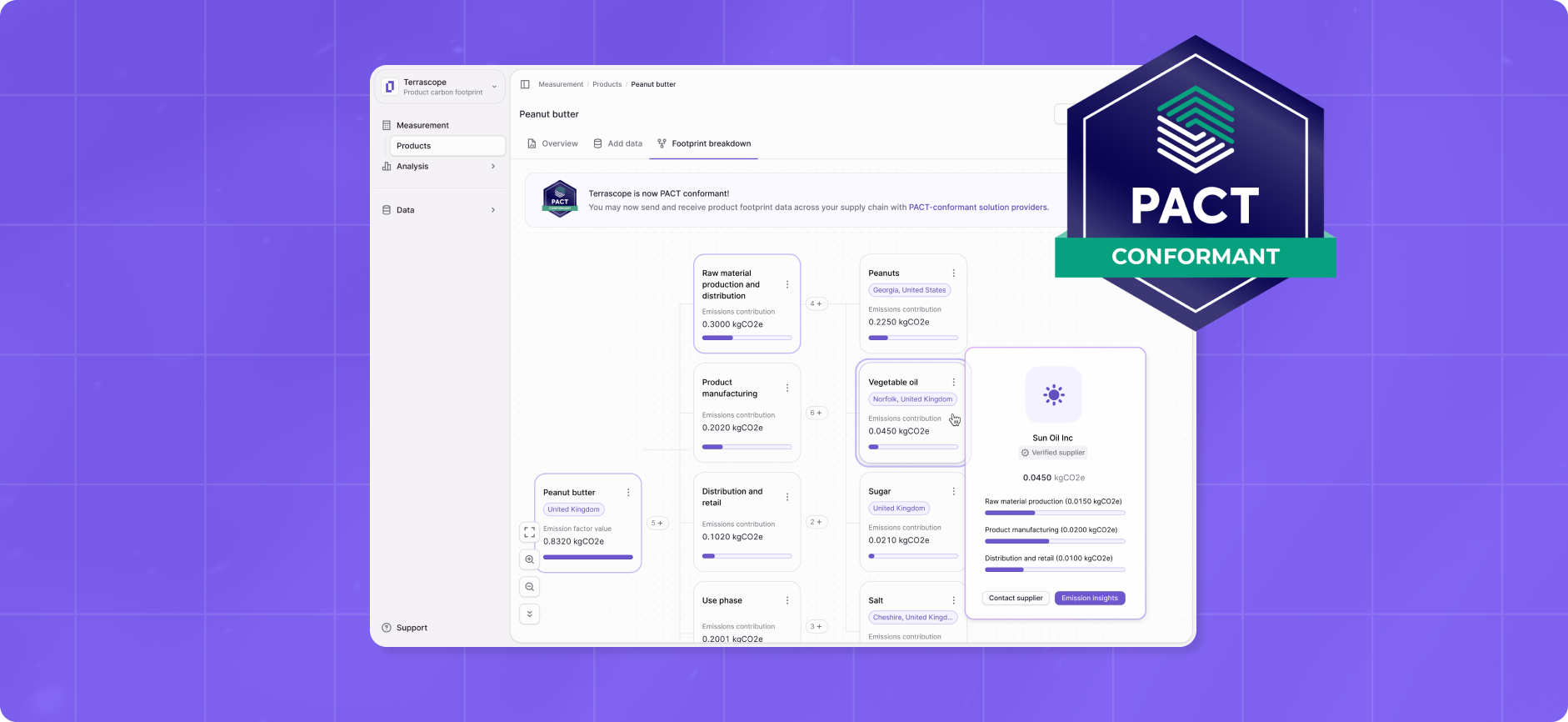Summary
- Terrascope CCO, Felipe Daguila, highlights the essential role of carbon management and ESG platforms in business, akin to the shift from mainframes to ERPs and CRMs in the past.
- Regulatory pressures and stakeholder expectations necessitate effective tracking and management of carbon emissions, particularly Scope 3 emissions, which represent a significant portion of total corporate emissions.
- Choosing the right carbon management software requires attention to policy alignment, support for net zero strategies, robust data integration, and effective emissions calculations to navigate the evolving landscape of sustainability.
"I vividly recall the early days of my 27-year career, during the meteoric transition from Mainframes to Enterprise Resource Planners (ERPs) and Customer Relationship Managers (CRMs). Just as how ERP and CRM systems were pivotal in the 80s and 90s, I have no doubt that Carbon Management and ESG Platforms will play a similar, essential role in the future of any business." - Felipe Daguila, Chief Customer Officer, Terrascope.
In this article, Felipe Daguila, Chief Customer Officer at Terrascope, emphasises the growing utility of carbon management platforms in the modern business landscape. As Felipe will explain, key benefits can be derived from using carbon management platforms, especially when it comes to assisting companies with their net zero journey.
Introduction
I vividly recall the early days of my 27-year career, during the meteoric transition from Mainframes to Enterprise Resource Planners (ERPs) and Customer Relationship Managers (CRMs). Just as how ERP and CRM systems were pivotal in the 80s and 90s, I have no doubt that Carbon Management and ESG Platforms will play a similar, essential role in the future of any business.
Carbon management software is increasingly pivotal in the business world due to the confluence of regulatory pressures and stakeholder expectations. This is also because these solutions track, manage, and report carbon emissions, a necessity in today’s environmentally-conscious market.
Environmental sustainability is constantly evolving, and it underscores how vital carbon management software has become in contemporary business strategy. This is because, according to IDC and Terrascope’s co-written report, The Imperative of Carbon Management Software in the Modern Business Landscape, carbon management software offers the direct ability to keep track of indirect Scope 3 emissions. Regulations worldwide have increasingly added greater responsibility onto corporates to account for their materiality – lest they face regulatory or legal penalties.
Indeed, these regulations have not emerged out of nowhere. This is primarily due to how Scope 3 emissions can constitute up to 90% of total emissions in sectors like food and beverage manufacturing, heightening the need for comprehensive carbon management solutions. With 59% of businesses worldwide having already set specific dates for achieving net zero CO2 emissions in line with wider governmental targets, the focus on operationalising Scope 3 emissions reduction has become paramount.
The Urgency of Carbon Management
As mentioned, regulatory pressure has made tackling Scope 3 emissions not only an environmental necessity but also a strategic business imperative, particularly in light of the upcoming European Corporate Sustainability Due Diligence Directive (CSDDD) regulations. Holding almost US$16.75 trillion in GDP, the European market is critical for any company thinking of having any presence in the region. CSDDD and its lateral regulations have influenced prior climate policy globally, particularly due to governmental knowledge sharing.
Abiding to CSDDD will necessitate attentiveness to its nuances, and as such, addressing these emissions effectively, can lead to notable improvements in cost efficiency, resilience, and risk mitigation.
With the CSDDD placing a stronger emphasis on comprehensive sustainability reporting and responsible corporate behavior, the management of Scope 3 emissions becomes even more crucial. To do so, they must involve sustainability data collection, calculation, and reporting, to meet the demands of customers, regulators, and investors.
How businesses might tackle this challenge, is indeed through the capabilities of technology, which can be transformative in reducing emissions. Emerging digital platforms, data analytics, and machine learning capabilities are essential tools for organizations to effectively collect, analyze, and act on emissions data. By operationalizing sustainability strategies with these technologies, businesses can improve their environmental footprint while unlocking new efficiencies and cost savings.
Indeed, when doing so, organizations must:
1. Conduct comprehensive value chain analysis: This involves identifying and prioritizing significant sources of Scope 3 emissions, including raw materials, transportation, and end-of-life disposal.
2. Engage with suppliers and customers: Developing reporting requirements for suppliers and working with logistics providers to track emissions is critical for comprehensive data collection.
3. Set ambitious reduction targets: Aligning with science-based targets and the Paris Agreement's goals is crucial for meaningful emissions reduction.
4. Leverage emerging technologies: Utilizing platforms and IoT for real-time tracking and monitoring of emissions across the value chain is essential for visibility and effective management.
5. Apply data analytics and machine learning: These tools can analyse large volumes of data to identify improvement areas, set reduction targets, and develop effective strategies.
The road ahead requires a deep integration of sustainability into business operations, supported by cutting-edge carbon management software. As regulatory pressures mount and stakeholder expectations evolve, enterprises looking to navigate this landscape successfully will need robust carbon management solutions indispensable in their journey towards a sustainable and profitable future.
Key Trends in the Carbon Management Software Market
The carbon management software market is diverse, with traditional players and emerging startups. A significant market trend is the increasing demand for such software, especially due to the granularity, and difficulty in tracking Scope 3 emissions. These emissions, which typically account for 75% to 100% of a business's emissions, apply particularly to firms which do not involve themselves in large-scale manufacturing or intensive electrical demand for their operations. This is also tied to financial services firms, as identified by the Terrascope and Verdantix report, the Rise of the Scope 3 Agenda among Enterprises.
The market is segmented by business size, industry focus, and software capabilities. Indeed, they differ based on sectoral expertise, alongside key functionalities such as:
- Data collection and management: Robust data collection from various sources for a comprehensive emissions profile.
- Emissions calculation: Advanced calculation methods to accurately quantify emissions.
- Automated reporting: Generation of detailed and compliant reports for various standards.
- Supplier engagement: Tools to engage and collaborate with suppliers for comprehensive emissions data.
- Scenario analysis: Modelling potential decarbonisation scenarios to guide strategy and investment decisions.
Advancements in AI and automation are expected, with a focus on Scope 3 emissions management. Furthermore, the market has also been in flux, with enterprises setting their targets, and demonstrating their commitments by investing in specialised software. From 2022 to 2025, we predict that the proportion of companies investing in Scope 3 management software will increase from 12% to 53% with added regulatory pressure.
How You Can Choose the Right Vendor
The five most important criteria when choosing enterprise carbon management software are
1. Policy and regulation alignment: The software should align with climate policy and market rules in relevant jurisdictions. This includes understanding future climate policy developments and being prepared for CO2 disclosure and climate risk reporting requirements.
2. Net zero and energy transition strategy support: The software should support the implementation of a net zero emissions strategy and aid in managing energy transition effectively.
3. Data acquisition and integration: Tools for facilitating data acquisition and integration capabilities with existing software applications are crucial. The ideal software should be able to consolidate information from various internal and external sources.
4. Carbon emissions inventory management: The ideal software must offer robust data management capabilities, including secure storage of data, application of emissions factors, and management of legal entity data. Features should also include AI for data gap identification and resolution.
5. Emissions calculations and financial management integration: The software should embed specific calculation methodologies and tools, including emissions factors, and integrate well with financial management applications for carbon pricing and internal cost allocations.
These criteria ensure that the selected software not only meets current regulatory and business requirements but also is capable of adapting to future changes and demands in carbon management and reporting.
Conclusion
Carbon management software is becoming integral to modern business operations, driven by regulatory demands and the need for detailed emissions reporting and management, especially for Scope 3 emissions.
The time to act and implement such software is now.



